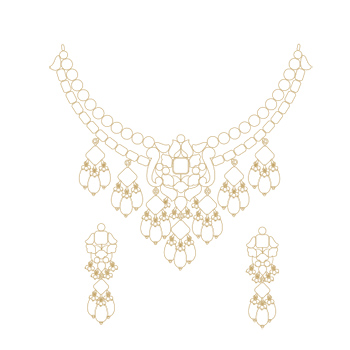India has a rich tradition of jewellery and there are a number of styles of jewellery making in practice. Kundan is a type of traditional Indian jewellery that uses a framework of gold crafted in intricate details to set chips of gemstones driven by form. So far, studies have been limited to documentation of existing pieces, family heirlooms, and collections of royalties published in the form of photographic documentation. jewellery was rarely studied scientifically, where precise measurements and mathematical interpretations of objects under observation were possible. The fundamental building block of Kundan jewellery is the smallest semantic unit, often identifiable by a name. An assemblage of these put together in a certain manner constitutes a cluster, which in turn, by repetition, constitutes an article. This three-part study focuses on the smallest semantic units that form clusters and their interplay to form a neckpiece.
An early part of the study elucidates preferential semantic units, arranged in a particular manner as clusters. Form clusters created by these preferential semantic units consequently influence likeness in a positive way and were used to create a line drawing of an article. Several such clusters were thus created, driven by the need for a tool to objectively study preferences for Kundan jewellery. A grid was proposed and developed, for purposes of understanding, as a three-dimensional visual array in the form of presentation plates. This grid was created to test the effects of three variables: cluster pitch, proximity variety, and the number of semantic units in a form cluster. This three-dimensional model was used as a virtual "test space" to see in which area of this space the preferential likeness of subjects fell. Actual-size test plates were created for subject presentation. People were approached, and a survey was conducted by reaching out to people and investigating their responses to presented designs. The data was analysed and presented in an easy-to-understand manner using diagrams and charts. Findings embody preferential likeness in the age cluster, marital status, and social status of user groups. This research takes a form-based approach to studying jewellery preferences.
